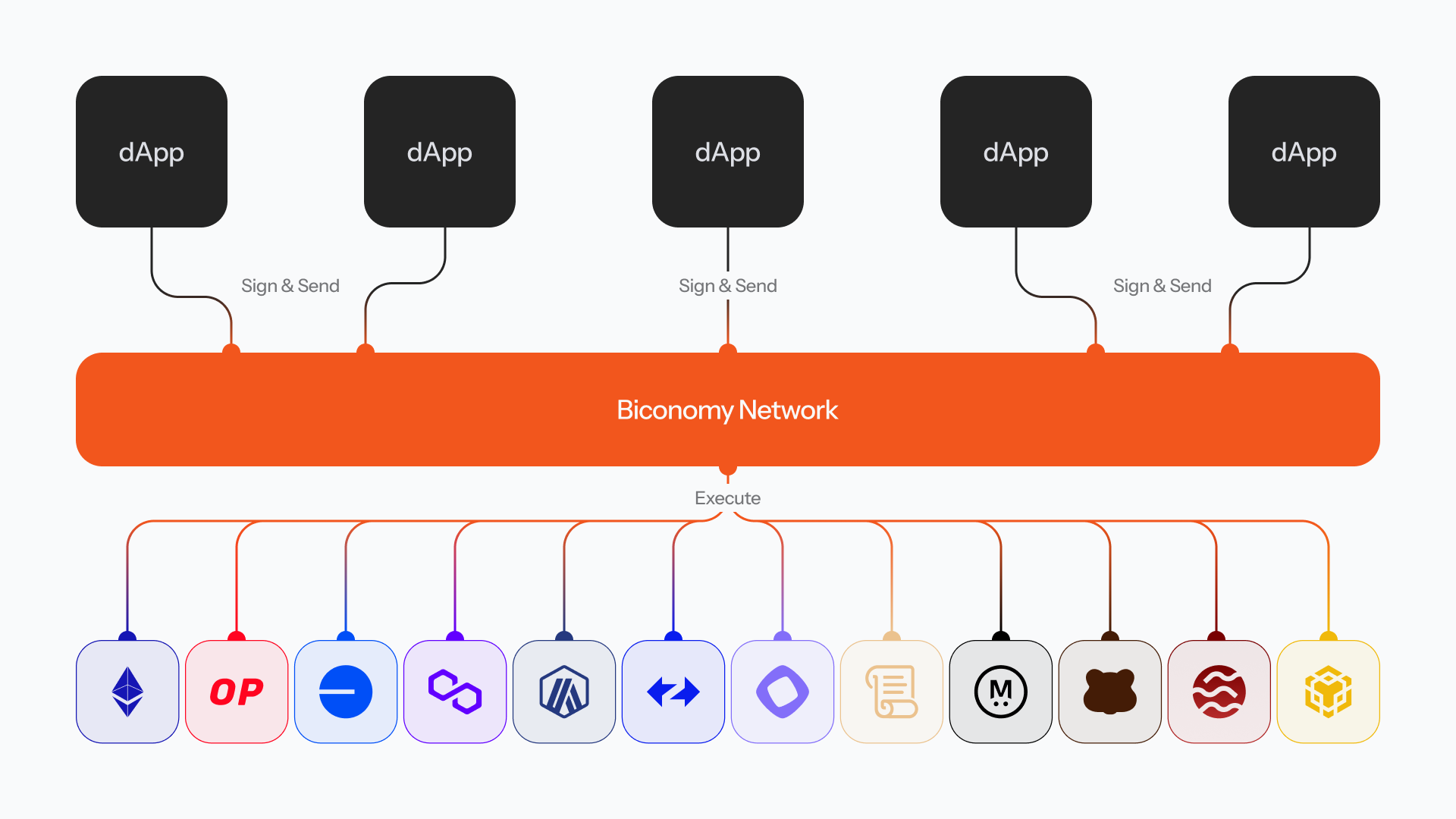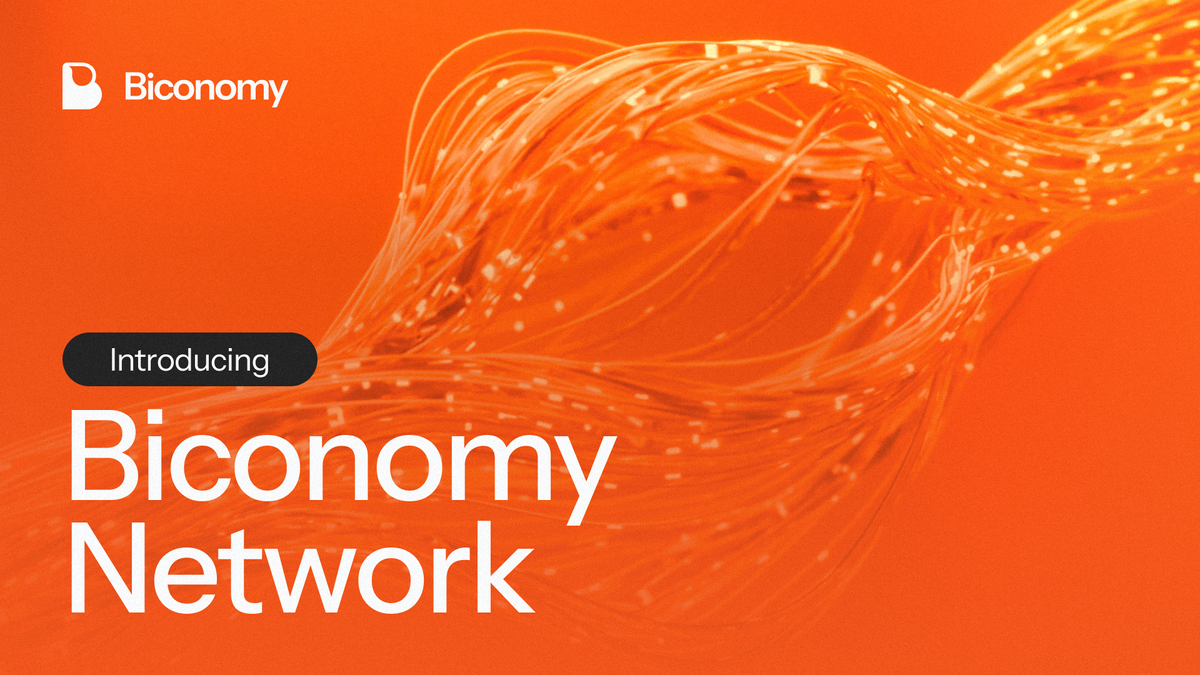The Modular Execution Environment standard introduced by Biconomy is a new approach to blockchain execution which decouples transaction permissioning (signing) and orchestration (committing to chain), from transaction processing/inclusion ("mining").
By leveraging MEE developers can write single-chain and multi-chain composable scripts which can drastically reduce their time to market, while increasing their iteration speed and security. The users get the benefit of single-signature execution across one or more chains with full chain and gas abstraction.
What can be done with MEEs?
- Sequence multiple transactions across multiple chains with a single user signature.
- Access hundreds of blockchains through a single node/endpoint
- Enable multichain gas abstraction
- Pay for gas in native coins or ERC20 tokens across chains. (e.g. pay for tx on Optimism with an ERC20 token on Arbitrum)
- Sponsor transactions on all chains with a single gas tank.
- Trustlessly schedule transactions for future execution or for repeat execution
- Compose transactions across single or more chains - use the output of one transaction as the input of another.
- Build complex composable DeFi flows, approved with a single signature.
- Allow agents and bots to prepare encode complex multi-chain and single-chain actions.
- Encode cross-chain swaps with additional calldata while controlling for slippage during runtime.
Unifying the Modular Blockchain

Modular Execution Environment is positioned as an orchestration and composability layer above L1 blockchains and rollups - enabling developers to post the desired actions to MEE - which then takes care of posting the transactions on the required chain(s).
Instead of managing multiple RPC endpoints and handling simulation and gas intricacies of chains (EVM compatible often means EVM compatible-ish), developers can just encode their calldata and let operators of MEE Nodes handle execution for them.
An additional benefit of having the orchestration layer above multiple blockchains is the ability to encode multiple actions which need to be executed across multiple chains and have MEE orchestrate them. By combining intelligent orchestration with support for composability (using the output of one transaction as the input of the next one) - we can achieve true single-chain and cross-chain composability on the application layer (app frontend or backend).

Powered by Supertransactions
Modular Execution Environments are powered by the Supertransaction data model. It enables permitting multiple transactions across multiple chains with a single user signature by hashing all the "child" transactions and packing them into a Merkle Tree. The user permits all of the transactions by signing the Merkle Tree root hash - called the Supertransaction hash.
Supertransactions can be thought of as "scripts", combining multiple instructions (even across multiple chains) into a single data structure, which is then approved for execution by a single user signature.
Instructions within the Supertransaction are composable, which means you can
How MEEs Work?
MEEs execute Supertransactions through a Quote/Execute process.
- Encoding a Supertransaction Request
The app/developer will encode all of the required instructions into an array of UserOps and send that array to the MEE Node. Additionally, the app/developer will express which token and on which chain they wish to pay gas in. - Building the Supertransaction and Returning the Quote
The MEE Node will run gas simulations and fill out the requiredgasLimitfields to create the Supertransaction. It will also prepend an additional UserOp which is the "Payment UserOp". This UserOp is the transfer of some token to the nodes own address. It's how the app/developer pays for transaction execution. Additionally, the node will encode the entire structure into a Merkle Tree. - Signing/Permitting the Supertransaction
Once the app/developer receives the filled Supertransaction from the Node, they can check the quoted price by checking the payment UserOp. If they are okay with the execution price, they can request the user to sign the root hash of the Merkle Tree which was returned by the node. This hash is called the Supertransaction Hash. - Committing and Executing the Supertransaction
After receiving the signed Supertransaction hash, the Node is permitted to execute all of the userOps contained within it. However, in order to claim the payment for the operation from the user, it must also sign the Supertransaction hash, with its own key. This will enable it to execute the payment UserOp. This signed hash serves as the commitment from the Node to execute the entire operation. In decentralized MEEs, this commitment is used to slash offending nodes.
Collaborative Execution & Biconomy Network
The MEE standard has been built to scale to 1000+ blockchains. To build a performant, highly-redundant design which can scale to such a level, MEE Nodes enable collaborative execution.
Collaborative execution enables multiple nodes to split the work of executing the instructions within a single Supertransaction. Imagine a situation where Node A supports OP Mainnet, Node B supports Base and Node C supports Polygon.
A developer encodes a Supertransaction with the following instructions:
- Swap WETH to USDC on OP Mainnet
- Call bridge contract to move half USDC to Base
- Call bridge contract to move the other half USDC to Polygon
- Swap received USDC into RETH on Base
- Swap received USDC into LINK on Polygon
In that case, transactions 1.,2. and 3. are executed by Node A since they're done on OP Mainnet. Transaction 4. is executed by Node B on Base and Transaction 5. is executed by Node C on Polygon. The transactions are not only executed, but orchestrated - meaning that the network respects the dependencies between the transactions and will wait for e.g. bridges to complete before proceeding with the execution of the next step.
The developer encoded only a single Supertransaction, the user signed only once and the Network made sure to find the Nodes capable of orchestrating all the instructions in the background.
Biconomy Network
The Biconomy Network is an upcoming decentralized MEE which aims to support 1000+ blockchains through collaborative execution. Biconomy Network will be a fully permissionless MEE which anyone can join.
Learn everything about the Biconomy Network from our announcement article:

AbstractJS + MEE Example
const { hash } = await meeClient.executeQuote({
quote: await meeClient.getQuote({
instructions: [
mcNexus.build({
type: "default",
data: {
chainId: optimism.id,
calls: [{ to: zeroAddress, value: 0n }]
}
}),
],
feeToken: {
chainId: optimism.id,
address: mcUSDC.addressOn(optimism.id)
}
})
})
